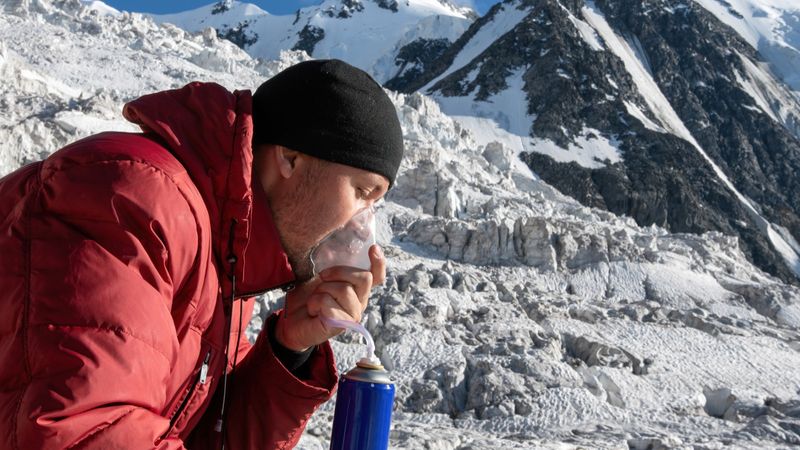The second wave of COVID-19 has left many infected patients gasping for breath and the unavailability of medical oxygen in hospitals across several states has become a concern. Social media, including WhatsApp, is filled with alternative methods to counter the acute oxygen shortage and there are many instances where misinformation is being peddled.
While a few of these shared messages talk about the benefits of lying face-down in prone position to improve oxygen levels, many suggest inhaling the vapour of camphor, clove, carom seeds and eucalyptus oil tied in a potli (cloth bag). Among them is Mukhtar Abbas Naqvi, Union Minister of Minority Affairs, who, early last week, shared a picture of the potli on Facebook claiming," (It) helps increase oxygen levels and congestion. This potli is given to tourists in Ladakh when oxygen levels are low. Many ambulances are now keeping these too. It's a home remedy." He has over four lakh followers on the social media platform and the post was shared multiple times before it was taken down.
At, Zee Zest, we did a quick fact-check to find out whether there is any truth in this viral claim, and if it can help improve oxygen levels among COVID-19 patients.
No potli for COVID-19, please!
Dr Ravindra M Mehta, senior consultant and head of department, pulmonology and interventional pulmonology at Apollo Speciality Hospitals, Jayanagar, Bangalore, dismissed the claim and said that it doesn’t help elevate blood oxygen levels. “Naturopathic solutions have been part of India’s heritage since time immemorial. There is no scientific proof in these modern times to substantiate it [camphor, clove, carom seeds and eucalyptus oil can increase oxygen levels]. Hence, I would put a cautious word out on behalf of the medical community that it is not advisable to depend on these and you must immediately seek medical help,” he further explained.
The ‘hero’ ingredient of this touted potli is touted to be camphor. According to a medically reviewed article on Healthline.com, camphor works as a decongestant and cough suppressant for adults, and hence, is used in vapour rubs but in a quantity not more than 11 per cent of the formulation. If inhaled or applied in high doses, camphor can cause redness and irritation. It can also cause respiratory problems such as coughing and wheezing when inhaled in high amounts. Pregnant or breastfeeding women and children under the age of two should not use camphor products at all, reads the article cautioning that it can prove fatal for toddlers, even in small doses.
Clove, carom seeds and eucalyptus oil, are frequently used in home remedies for their individual medicinal properties but have no scientific data to back up the oxygen levels claim. However, Sangeeta Khanna, a Dehradun-based nutrition consultant and recipe developer, recently took to Instagram to share that this combination of herbs and spices can be effective in relieving congestion in the upper respiratory tract and associated headache.
High altitude sickness and COVID-19

A part of the viral claim says that this potli is given to tourists when they visit high-altitude places such as Ladakh. But experts have said that equating high altitude sickness with COVID-19 is like comparing apples and oranges. “When you are in a high-altitude region, your lungs are fine but there is a scarcity of oxygen in the environment. However, in the case of COVID-19, there is enough oxygen in the environment, but your lungs are hit by a viral infection that affects the ability to inhale and exhale properly,” explains Vikas Chawla, an ayurvedic pharmacist and founder-director, Vedas Cure.
Adding to this, Dr Mehta says, “It is different for Ladakh and other high altitudes; what you experience there is short level hypoxia. But COVID-19 is an acute illness caused by a viral infection and in this, the person is sick and his/her whole body is impacted.”
Several mountaineering and trekking groups on the internet insist that people carry adequate camphor for help in clearing the nasal pathway and assistance in breathing. In fact, serial mountaineer and nutrition coach Kuntal Joisher says, “There are no hacks or shortcuts to staying well at high altitude. I saw the WhatsApp forward and the claim is inaccurate. It doesn’t help with anything let alone oxygen levels.” His suggestion for people travelling to high altitudes is to go through a proper acclimatisation process to manage oxygen levels better.
Feel-good and no more
Both Dr Mehta and Chawla suggest that people can turn to this potli to make themselves feel good when their lungs are fine. But if there is an acute problem or your oxygen levels are dropping, you need to seek medical help and an external source of oxygen is required.
A normal level of oxygen (oxygen saturation) of the blood on a pulse oximeter is usually 95 per cent or higher and, for an arterial blood gas test it is 75 to 100 millimeters of mercury (mm Hg). When you blood oxygen falls below the aforementioned readings, you may call for emergency support and an external source of oxygen is required. The government of India recently shared an eight-step guideline on how to check the oxygen level using a pulse oximeter. Check it out below:
So, one can see that this viral potli doing the rounds on your WhatsApp group, containing camphor, clove, carom seeds and eucalyptus oil, is not effective in increasing blood oxygen levels. It may help relieve congestion and associated headache, but those aren’t proven claims either. Be it high altitude or COVID-19, seeking medical help if your body is facing a shortage of oxygen, is a prerequisite.




